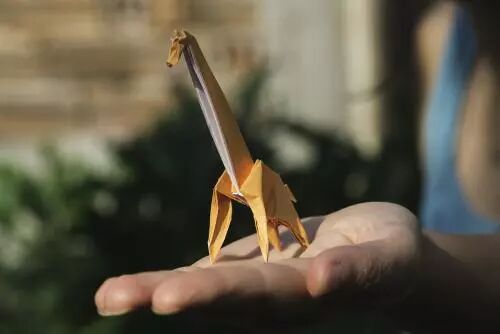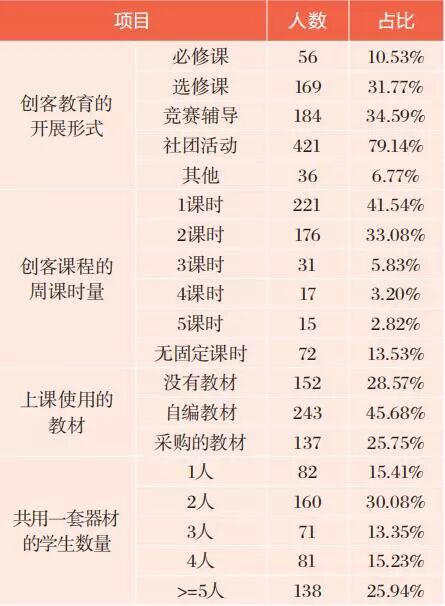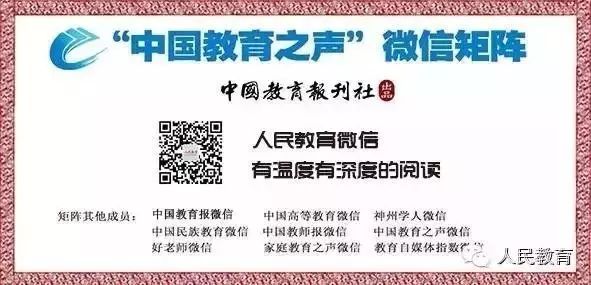Editor’s Note
In just a few years, “Maker Education” has transformed from a new term into a familiar presence in the curricula of many primary and secondary schools. The concept of “making” has been integrated into education, injecting new vitality into vibrant frontline educational practices.
A survey on Maker Education has revealed some encouraging changes in recent years, with several exemplary experiences emerging. However, there are still issues in the implementation of Maker Education, such as insufficient teaching staff, lack of resources, and challenges in sustainable development. What is the correct approach to Maker Education, and what are the future directions? Let’s explore together!
Written by | Zhong Baichang, Zhang Lu, Wang Yanxia

To comprehensively understand the development status of Maker Education in primary and secondary schools in China, we conducted a large-scale questionnaire survey on Maker Space construction in 2015, which yielded some valuable findings. Two years later, have there been new changes in Maker Education? What issues deserve more attention? How should we respond? To answer these questions, we conducted an even larger survey.
01
From “Lack of Teaching Staff” to “Regionally Collaborative Maker Teacher Teams”
Many difficulties have been encountered in promoting Maker Education across various regions, with one prominent issue being the lack of Maker educators. A total of 1,537 teachers participated in the survey, primarily consisting of information technology teachers. After rigorous consistency checks, 532 questionnaires were deemed valid, and the survey results reflect numerous staffing issues faced by Maker Education.
Among schools implementing Maker Education, 62.22% have no more than two teachers (referred to as “Maker Teachers”) involved in Maker Education. Among these Maker Teachers, 89.10% of schools have information technology teachers participating, indicating that information technology teachers remain the primary force in the current implementation of Maker Education in schools.
Notably, 12.59% of schools have art teachers involved, suggesting that these schools may recognize the importance of art or design in the “making” process. Additionally, 4.70% of schools have enthusiastic parents participating. Overall, both the quantity of teachers involved in Maker Education and the diversity of their sources still have significant room for development.
Compared to the 2015 survey on Maker Spaces, the distribution of respondents’ teaching experience and the locations of their schools remained largely the same, but the gender ratio of teachers has significantly narrowed (the proportion of males decreased from 85.5% to 57.52%), and the proportion of information technology teachers has notably increased (from 50.8% to 72.74%). The proportion of schools conducting Maker Education at the primary school level has also significantly increased (from 34.8% to 57.14%), indicating that Maker Education is transitioning from a few elite teachers to a more normalized development stage led by general teachers, particularly information technology teachers, in conjunction with information technology courses, and is expanding significantly at the primary school level.
It is worth noting that a considerable number of teachers from township and rural schools are engaged in Maker Education, and their attention to Maker Education will be a key factor in its future development.
Surveys on Maker Teachers’ attitudes reveal that the majority (87.97%) of schools have teachers voluntarily participating in Maker Education, with only 12.03% of schools completely relying on leadership to assign teachers for Maker Education. Coincidentally, the proportion of schools that completely rely on leadership assignments corresponds to the percentage of those dissatisfied or very dissatisfied with their Maker Education.
However, further statistical data show that among the 64 teachers who selected “all are assigned by leadership,” only 20.31% expressed dissatisfaction or very dissatisfaction with their school’s Maker Education, while 34.38% reported being satisfied or very satisfied. This statistic indicates that as long as the right people are chosen and management measures are in place, even if teachers are assigned by school leaders, satisfactory Maker Education outcomes can still be achieved.
Of course, the overall satisfaction rate of teachers with their school’s Maker Education is only 51.88%, indicating that there is still significant room for improvement in current Maker Education.
In the 2015 survey on Maker Spaces, the option “all are assigned by leadership” was 0, while in this survey, it accounts for 12.03%. The proportion of “all are voluntary” has decreased from 71.01% to 45.49%, indicating that as Maker Education transitions from an elite orientation to widespread promotion, there has been a strong administrative intervention; satisfaction levels have also slightly improved (the number of satisfied and very satisfied individuals increased from 46.37% to 51.88%), while dissatisfaction levels have remained relatively stable (the number of dissatisfied and very dissatisfied individuals decreased from 13.04% to 12.03%).
Implementing Maker Education requires an excellent teaching team. Currently, most teachers involved in Maker Education are information technology teachers, who possess strong sensitivity and application abilities regarding advanced technologies, enabling them to provide professional guidance to students in software and hardware technologies, advanced programming, and electronic components. However, this is still far from sufficient. Maker Education differs from traditional education; it is a creative educational activity that integrates high complexity and strong comprehensiveness, placing high demands on teachers’ and students’ physical, intellectual, and perseverance capabilities. During students’ Maker learning processes, teachers need to provide guidance in knowledge and technology, as well as psychological support, such as inspiration and emotional comfort.
Therefore, in addition to the essential teaching abilities, Maker Education also requires teachers to possess multidisciplinary knowledge and outstanding inspirational abilities. However, the integration of multiple courses in Maker Education poses significant challenges for most traditional subject teachers.
The experience of actively cultivating and building a “regionally collaborative Maker Teacher Team” in Xishan District, Wuxi City, Jiangsu Province is worth referencing.
First, promote complementary collisions. Maker Education includes programming in information technology, scientific experimentation and production, as well as summarization and expression in language, and also involves design and aesthetics. Therefore, during the promotion of Maker Education, Xishan District encourages information technology teachers from various schools to collaborate with teachers from science, art, and other subjects, forming teacher Maker teams through joint guidance.
Among the core Maker team members in Xishan District, in addition to key information technology teachers, former art teachers who transitioned to information technology subjects, technical experts with specialties in the Internet of Things and animation, and young teachers developing in both information technology and science have been included. This diverse Maker teacher team has effectively led and promoted the development of Maker Education in the district.
Secondly, strengthen leading collisions. For some information technology teachers, Maker Education is also a relatively new concept. Coupled with a lack of systematic training and guidance, information technology teachers often encounter unsolvable technical problems during exploration and promotion.
Therefore, information technology researchers in Xishan District actively collaborate with the Wuxi City Educational Technology Center, providing various project training for information technology teachers every summer, including “Scratch,” “Internet of Things,” “NOC Referee,” and “Maker”. Information technology teachers can choose one or more projects for training based on their needs. To enhance teachers’ initiative in participating in training, all training costs are covered by the school’s special funds for modern educational technology, and the training hours are included in the annual continuing education assessment.
Thirdly, solidify experience-based collisions. Due to differences in funding input and teacher technology, the development levels of Maker Education in various schools vary. To ensure balanced development of Maker Education in the district and enhance teachers’ enthusiasm for Maker Education research, the district’s research office organizes teachers from the information technology subject group to visit schools with outstanding Maker Education work during each semester’s modern educational technology conference and information technology subject meeting, inviting key Maker Education teachers to share their experiences, which has been well received by information technology teachers in the district.

02
From “Insufficient Funding Resources” to “Resource Sharing”
Maker Education requires financial support, and the equipment, materials, textbooks, and other software and hardware needed for Maker Spaces incur corresponding costs. Moreover, as Maker learning continues, the maintenance and repair of these devices and the ongoing supply of consumables also represent a significant expense. Therefore, Maker Spaces require relatively stable funding injections to ensure their normal operation.
Although open-source hardware has reduced the costs of equipment and consumables, the inertia of pursuing “high-end” solutions, along with insufficient educational funding or limited capacity to expand external resources, has led some schools to still be unable to afford the costs of implementing Maker Education, hindering its promotion.
This survey indicates that 72.37% of schools invest less than 100,000 yuan in Maker Education (with 50.75% investing less than 50,000 yuan and 21.62% investing between 50,000 and 100,000 yuan), indicating that current funding for Maker Education is at a relatively moderate level. Given that Maker Education primarily involves cost-effective open-source hardware and its consumables, an investment of several tens of thousands of yuan by a school can generally meet the basic needs for implementing Maker Education. A considerable number of schools (8.46%) have funding exceeding 300,000 yuan, theoretically allowing them to build a relatively well-equipped Maker Space or Maker Lab. In terms of funding input, the results remain consistent with the 2015 survey on Maker Spaces.
For Maker Education, Maker Spaces are the primary venues for learning activities. In Maker Spaces, learners creatively apply various technical and non-technical means, collaboratively discovering problems, deconstructing issues, seeking solutions, and through continuous experimentation, forming creative project products, ultimately achieving comprehensive growth that includes interpersonal communication, teamwork, innovative problem-solving, critical thinking, and professional skills.
This survey found that only one school (0.19%) has not yet established a Maker Space, indicating that Maker Spaces have become standard for schools currently implementing Maker Education. During the construction of Maker Spaces, 46.33% of schools received support from educational bureaus and educational technology centers, 71.56% of schools raised construction funds independently, some schools (4.33%) received corporate sponsorship, and 9.98% of schools raised funds through individual teachers, while 6.40% of schools lacked clear funding sources.
Overall, the current funding sources for building Maker Spaces primarily rely on schools and individual teachers’ self-raised funds, and the support from educational administrative departments needs to be strengthened.
Regarding the usage of Maker Spaces, 17.70% of schools only open them when there is a special need, and 13.37% of schools do not have free open periods. However, Maker Education needs to fully utilize flexible extracurricular time; in this sense, the free opening of Maker Spaces is an important prerequisite for ensuring the effective realization of their educational value. Currently, some schools’ inability to achieve free opening of Maker Spaces is often related to insufficient Maker teaching staff.
In the operation of Maker Spaces, the survey shows four main obstacles, ranked from highest to lowest: lack of teaching staff (68.92%), insufficient funding (65.72%), inadequate hardware and space (56.69%), and unrecognized workload (47.27%). In the 2015 survey on Maker Spaces, the four major obstacles were: insufficient funding (73.91%), lack of teaching staff (69.57%), inadequate hardware and space (52.17%), and poor management (37.68%). In comparison, the issue of teaching staff has become increasingly prominent, while the problem of insufficient funding has somewhat eased; however, overall, insufficient funding resources remain a major issue facing Maker Education.
In the context of insufficient funding resources, how can Maker Education be implemented? Xiantao City in Hubei Province has effectively addressed this issue through top-level design, resource sharing, regional promotion, and collective improvement.
Based on the “Information Technology Subject Workroom for Primary and Secondary Schools in the City,” Xiantao City has convened eight outstanding frontline teachers to form a “Core Subject Team” and created the “Little Maker Space.” The “Core Team” is responsible for researching the “Maker Curriculum” for the entire city, delivering lessons to schools, and verifying courses, while also tasked with creating regionally distinctive courses.
Schools in the city are categorized into experimental schools, base schools, and cooperative schools. Experimental schools are responsible for designing and verifying courses, with the “Little Maker” from the workroom providing teaching staff to schools; base schools share courses, verify and provide feedback on courses, with the workroom training teachers for schools to achieve “self-teaching”; cooperative schools need to crowdsource courses from the “Little Maker Space,” with workroom teachers delivering teaching services to cooperative schools while also training a teaching staff capable of conducting Maker Education.
In addition to teaching staff, Xiantao City has also achieved citywide sharing of equipment and courses for Maker Education, greatly saving manpower, financial resources, and material resources. In terms of course development, fun programming with Scratch, 3D design and printing, Arduino and sensor design, VR/AR, and other Maker courses are researched by nine outstanding teachers from eight schools, forming a relatively comprehensive “Little Maker” curriculum system, allowing them to circulate teaching across the city and achieve shared teaching staff. They also utilize the only 3D printer available in the city, enabling children in the region to experience the entire process of 3D design and printing.

03
From “The Trend of Maker Education” to “Sustainable Development of Maker Education”
As some researchers have pointed out, the biggest issue facing Maker Education is sustainability. While people recognize the importance of Maker Education in cultivating children’s innovative abilities, they are more concerned about whether it will affect children’s academic performance and advancement.
Moreover, Maker Education also faces issues of educational equity and balance, as well as conflicts with the traditional education system, all of which are unavoidable challenges for achieving sustainable development in Maker Education. Although Maker Education is a product of the development of the times and educational reform, it is not the last lifeline for educational development and cannot solve all educational problems.
Today, under the influence of educational technology product producers, media hype, and educators’ anxiety and eagerness regarding educational reform, Maker Education seems to have become a “panacea.” Therefore, practitioners and researchers should consider the sustainability of Maker Education from multiple perspectives, thinking calmly and not blindly following the “Maker Education trend.”
The normalization of Maker Education cannot be separated from specific educational forms. The primary question is whether Maker Education should be conducted in the form of courses. Survey results show that the current forms of conducting Maker Education are quite diverse (see the table below), including compulsory courses, elective courses, competition guidance, and club activities, among which club activities remain the most common form of Maker Education.

For Maker Education, its essence is an experiential course that should primarily be conducted in the form of comprehensive practical activities, while related subject courses mainly serve as foundational support for Maker Education, with technology courses, especially those related to robotics, being prerequisite courses for conducting Maker Education. Broadly defined comprehensive practical activities can also include interest group activities and science and technology club activities. In these different courses and activities, the participating student groups vary, allowing for complementary advantages, combining points and areas, and collaboratively conducting Maker Education. Therefore, the normalized implementation of Maker Education must be diverse in its educational forms. It is essential to break free from the limitations of traditional technology club activities and move towards a broader Maker Education space.
To achieve the normalization of various educational forms, many details need to be considered. For example, regarding weekly class hours, most schools allocate a fixed 1-2 class hours per week for Maker Education. However, given the nature of Maker Education, fully utilizing flexible extracurricular time to freely conduct making activities in Maker Spaces is more conducive to cultivating students’ practical innovation abilities and aligns more closely with the normalized implementation of Maker Education.
Additionally, regarding equipment configuration, having one set of equipment per person is not an ideal state. Foreign scholars emphasize that one important reason for adopting project-based teaching methods is that Maker Education needs to emphasize students’ collaborative learning. Existing research indicates that from the perspective of collaborative problem-solving, a group of four is the recommended group size, but student participation is lower in groups of two or three. Therefore, in this sense, controlling the number of members in Maker learning groups to 2-3 is most appropriate. However, this survey found that the proportion of groups of 2-3 sharing one set of equipment is less than half.
Moreover, the survey found that among schools implementing Maker Education, 36.09% have 20 or fewer students participating, making it the largest category; 32.33% of schools have 21-40 students participating, ranking second.
These two data points indicate that the current elite orientation of Maker Education remains evident, contrary to the original intention of Maker Education. The sustainable development of Maker Education needs to be based on popularization, with its foundation lying in cultivating students’ innovative literacy. It is encouraging that in this survey, 19.55% of schools have a Maker Education scale exceeding 80 students.
(Author affiliations: Zhong Baichang, Wang Yanxia, School of Education Science, Nanjing Normal University; Zhang Lu, Wuxi No. 1 Middle School. Note: The complete report of this survey, “National Primary and Secondary School Maker Education Development Report 2018,” will be published soon.)

Source | “People’s Education” 2018, Issue 5
Editor | Xing Xing
WeChat Editor | Wu Ling
Recommended Reading
Gu Mingyuan: Will Future Education Be Changed by Technological Advancements?
Wu Guosheng: The Education Sector Need Not Be Overly Sensitive to Any Progress in Technology
[Feature] Have you heard that Qibao Middle School in Shanghai has transformed into an “Innovation Ecological Laboratory”? Come and take a look with the editor!

Long press the QR code to follow us
For submissions and collaborations, please contact [email protected]
